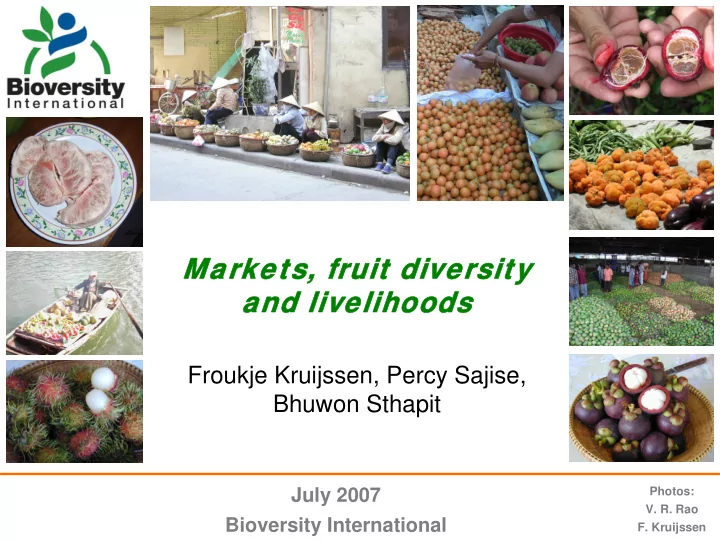

Markets, fruit diversity Markets, fruit diversity and livelihoods and livelihoods Froukje Kruijssen, Percy Sajise, Bhuwon Sthapit Photos: July 2007 V. R. Rao Bioversity International F. Kruijssen
Introduction • The well-being of the growing world population depends on the availability of biodiversity. • More integrated and complementary approaches to conserve biodiversity used • Marketing of products with agrobiodiversity traits to give farmers incentives to maintain diversity on farm • More understanding needed of trade-off • Conceptual framework to assess markets for diversity developed • Case examples of tropical fruits.
Framework Intervention 4 A ii Intervention 2 Agrobiodiversity on farm O A Intervention 3 A iii Counterfactual A i Intervention 1 I iii I ii I i I On farm income
Citrus in India Successful case: • In Northern-Eastern Hills of India Kachai lemon ( C. jambhiri ) a high yielding citrus landrace was identified • The variety produced large yield with uniform fruit colour. • Liked due to its special flavor and high juice content. • Local traders are collecting and marketing to juice processing factories • An entire village (300 households) cultivate a total of 4000 Kachai lemon trees • Contributes to farm household income
Citrus in Nepal Unsuccessful case: • Five decades ago Pokhara valley in Nepal accommodated a large genetic diversity of Citrus spp. • Mass introduction of citrus saplings from India to Nepal in 1960 • Eroded indigenous citrus germplasm from the area • Also introduction of diseases with plant material • Local mandarin (CHAKSI) landraces vanished
Citrus in India and Nepal A1 1a. Citrus, 1a India Agrobiodi- versity on farm 1b 1b. Citrus, Nepal A2 I1 I3 I2 On farm income
Wild fruits in the Philippines • Tribal community in mossy rainforest of Imugan, Philippines. • 1950-1970: Rampant forest degradation when land tenure was not secure • When the community obtained recognition of ownership for 15.000ha they went from forest destruction to forest protection • Need for food and cash, no possibility to expand agricultural land. • Potential of wild fruit species for marketing was explored, starting with fruit processing. • Species: guava (Psidium guajava), dagwey (Sauriuia bontocensis) and biho-lak (Embelia philippinensis) • Products: jelly, raisins, spread and vinegar • Products recognized and popularized in supermarkets in Manila • Encouragement to conserve them, thereby conserving existing diversity of wild fruit species in the forest. • Further increase in number of native fruit species for fruit processing and bringing in new species from the forest to their farms. • This further increased diversity of the fruit species in their tribal domain.
Wild fruits in the Philippines A1 1a. Citrus, India 1a Agrobio- A3 2. Wild fruits diversity on farm 2 1b 1b. Citrus, Nepal A2 I4 I1 I3 I2 On farm income
Longan in Vietnam • Dimocarpus longan, underutilised fruit • In Vietnam, traditional fruit trees in home gardens face several problems: poor fruit quality, old trees, fruit pest and disease and poor tree management • Quality improvement possible through adoption of modern management techniques • Local communities and nurserymen propagated new grafted saplings of longan and mango fruit varieties in community nursery • Planting material marketed within and between villages. • May replace existing longan and mango diversity in home gardens • In Southern Vietnam genetic diversity is being replaced by vegetatively propagated longan, litchi and pomelo • GEF conservation project supported longan farmers to dry longan flesh or fruits for long distance marketing but this has ecological cost (firewood).
Longan in Vietnam A4 3. Longan 3 A1 1a. Citrus, 1a India Agrobio- A3 diversity on 2. Wild fruits farm 2 1b A2 1b. Citrus, Nepal I4 I1 I3 I2 On farm income
Garcinia in Thailand • The cultivated Garcinia species have very narrow genetic variability • But there is a high level of inter-specific diversity (up to 100 species of which 30 have edible fruits) • Many have some commercial value • In Thailand is a women group processes the leaves of Garcina cowa • Both the young shoots and the fruit (berry) are edible • Raw material for a traditional dish containing cowa leaves is procured from the members of the cooperative • They harvest young shoots from their homegardens • When trees become too high to easily harvest the leaves, trees are either cut halfway or new seedlings are planted. • Estimated annual profit of cowa and other products is US$5000 • Also members receive wage payment for labour for the production at US$3 per day. • This has substantially increased the women’s income and has given an incentive to maintain the cowa trees.
Garcinia in Thailand A4 3. Longan 3 1a. Citrus, A1 India 1a 2. Wild fruits Agrobio- A3 diversity on farm 1b 1b. Citrus, 2 Nepal A2 A5 4. Garcinia 4 I4 I1 I5 I3 I2 On farm income
Discussion • Tropical fruits can provide an important source of income and nutrition • Markets have the potential to increase / maintain demand for fruit diversity on farm • But: trade-off takes place and need to be further analyzed • Framework so far fails to incorporate social benefits (apart from income) • Tools needed to quantify the value of the axes • Conducive policy framework and inclusive methods needed to ensure that diversity will benefit
Thank you for your attention Thank you for your attention
Recommend
More recommend